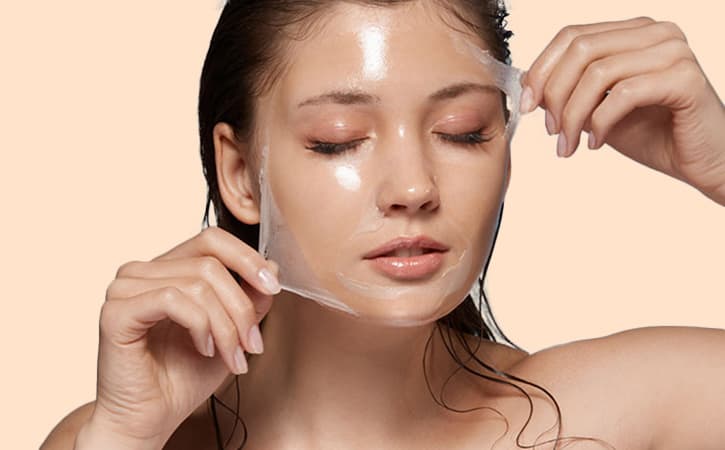What are Chemical Peels?
A chemical peel is a cosmetic procedure in which a chemical is applied to the skin, after which the top layer eventually peels off. Dermatologists perform it in their clinic or office. The new layer of skin is much smoother and clearer. This procedure is ideal for the skin of the face, neck, and hands.
The chemical peels are generally made from glycolic acid, carbonic acid, trichloroacetic acid, lactic acid, and tartaric acid. The aim is to improve the skin’s appearance and texture.
What are the Types of Chemical Peels?
There are three basic types of chemical peels are:
Superficial Peels
In this type of chemical face peel, a mild acid penetrates only the top layer of the skin. It is ideal for light skin with discolouration or rough skin. It is also referred to as lunchtime peel.
Medium Peels
This peel is used to exfoliate the middle layer of the skin. These peels contain glycolic acid and are ideal for treating age spots, wrinkles, fine lines, skin discolouration, and freckles.
Deep Peel
The deep peel uses trichloroacetic acid that penetrates deep into the skin. It treats age spots, freckles, and scars that greatly impact the skin.
Your dermatologists can help you know the chemical peels and which will best suit your skin type and condition.
How Safe is Chemical Peel?
Chemical peels are highly safe. Moreover, when performed by certified healthcare providers or experienced dermatologists, they can easily mitigate complications. To avoid risks, one should always follow their healthcare provider’s advice and tips after the procedure.
What to Expect from Chemical Face Peel?
Let us know about the chemical peels procedure:
- Before
Before getting the chemical peel done, you need to consult your dermatologist. In some cases, your healthcare provider may not suggest undergoing it. It is best to avoid the peel if you take medicines for acne, has abnormal skin pigmentation, or are prone to cold sores.
Moreover, it is mostly recommended for people with fair skin. Darker skin people generally have uneven skin tone, which is unsuitable for the chemical peel.
Before the procedure, you should avoid scrubbing, waxing, bleaches, or massages at least a week prior. Moreover, some skin creams or medicines may be avoided before the procedure. Consult your doctor to know more.
- During
During the chemical peel procedure, the doctor will clean your face properly to remove any pollutants or debris. The eyes, lips, and hair are covered. If you are undergoing medium peel, you will be given sedatives.
Local anesthesia is administered for the deep peel; however, there is no need for painkillers for the light peel.
The peeling solution is applied to the skin by trained and licensed skin specialists. It is kept for the desired time, and a neutralising solution is applied. It is common to experience a burning sensation for 5 to 10 minutes during the procedure. It is reduced using ice compress or pain medications.
- After
The skin becomes sensitive after the procedure, becoming prone to sun damage. Protecting your skin using sunscreen of SPF 30 or more is recommended. Also, avoid direct exposure to the sun as much as possible. The redness and scaling will last 3 to 7 days after the procedure.
Following your doctor’s recommendations and advice throughout the procedure is vital to avoid complications.
What are the Benefits of Chemical Peels?
Some of the benefits of chemical peel are:
- It exfoliates the skin
- The procedure helps to remove the dead skin
- It reduces the fine lines around the eyes and mouth area
- Chemical peel benefits by treating wrinkles caused by skin damage.
- It treats acne scars, freckles, age spots, dark patches, and melasma.
Book an appointment with your healthcare provider to reap the benefits of the chemical peel.
Are There Any Side Effects of Chemical Peels?
Some of the side effects that the chemical peel can cause are:
- It can cause a temporary or permanent change in skin colour. The colour change is mostly found in women who are on birth control pills or subsequently become pregnant. Moreover, those with facial discolouration history are also prone to this issue.
- It can trigger infections such as herpes in some people.
- The deep chemical peel using phenol can damage the organs such as the heart, liver, and kidney.
- The scarring caused by the chemical peel can last for a lifetime.
Consult your dermatologists before getting a chemical peel if the procedure suits you.
How do chemicals peel at Home?
Follow these steps to do a chemical peel at home:
- Before starting, do a patch test.
- At the start, keep the skin peel chemical for 30 seconds and increase the time every week by 30 seconds.
- For aftercare, use a good sunscreen and moisturiser.
If you see any complications, immediately contact your dermatologist or healthcare provider.
What is the Ideal Age to Get Chemical Peel Done?
Dermatologists suggest that one can start doing chemical peels in the 20s. Using peel in your 20s or 30s helps to keep the skin fresh in later years. It is not only useful to prevent ageing spots but also helps to reduce acne. The chemicals help to unclog pores, sebum production, and blackheads.
Can Chemical Peel Be Done After Microdermabrasion?
Microdermabrasion is a procedure that involves the use of a handheld device to exfoliate the top layer of the skin. A chemical peel can be used after the microdermabrasion. In fact, both these procedures are used in combination for oily and acne-prone skin.
What are the differences between Facial and Chemical Peel?
| Facial | Chemical Peel |
| Reduce skin damage and provide skin barrier strength to improve cell reproduction. | Provides smoother skin free from acne, wrinkles, and age spots. |
| Make use of cream, serums, scrubs, and blackhead extractors. | A chemical is used to peel off the top layer of the skin. |
| No recovery time | Takes around a week to recover. |
| No side effects | Some people experience side effects |
| Shows result after regular facial | Results are visible after one chemical peel procedure. |
How long does Skin Take to Peel after Chemical Peel?
After the procedure, you can experience skin peel within 24 to 72 hours. It can last for around 2 to 5 days. It is common to experience a burning sensation and itching, but one should avoid picking their skin. Moreover, try using a good moisturiser and sunscreen.
Conclusion
Chemical face peel is an effective skin treatment that provides smoother, clearer, and fresh skin. It exfoliates the skin and helps to treat acne scars, wrinkles, freckles, and other ageing spots.
Contact an experienced dermatologist to know before getting chemical peel whether it is the right treatment for you or not. Visit PVR Aesthetica to know about the chemical peel.


